There was red dirt, blazing sun and road trains rumbling past; as over 100 cyclists gathered at the start of May for the Tour De Carmichael. Cars are pretty scarce there on the corner of the Gregory Highway and Moray-Carmichael Rd, let alone pushbikes. It was a long way from the average Sunday morning lycra-clothed cycle ride .
We were over 1000km north-west of Brisbane, 380 west of Mackay, and 85 from Adani’s Carmichael coal mine site – our planned destination. Wangan and Jagalingou Traditional Owner Coedie McAvoy initiated the tour as a way to get people up to this remote part of central Queensland, to experience his country and witness the destruction Adani is causing to it.
Plenty of people heeded the call, and so, after the immense logistical effort of getting over 100 people and their bikes to the startline, an excited crowd gathered – freshly attired in shiny white Tour De Carmichael t-shirts (how long would they last?).
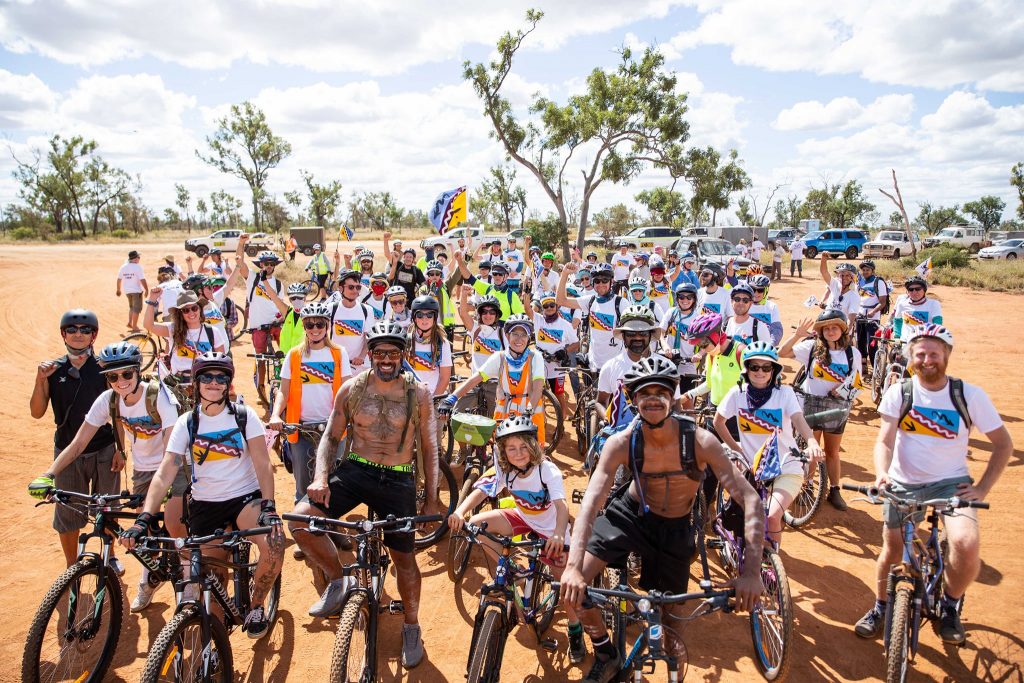
The ride would leave from the highway on Jangga country, a few kilometres from where Adani and their contractors are trying to build a rail overpass. We would pass through a classic outback scene of dusty roads, brigalow scrub and cattle farms the size of European nations; to arrive at possibly the world’s most controversial development. Adani’s open cut mine if built to its conclusion would extract and export 60 million tonnes per annum of thermal coal, and open up the path for more coal mines in the as yet unexploited Galilee Basin. It is more coal in a world that simply cannot afford it if we are to stay under the catastrophic warming level of a two degree celsius rise.
That’s the climate case against this mine, there is also the land rights case. There has been an immense struggle between Wangan and Jagalingou and Adani since the Traditional Owners unanimously rejected Adani’s first offer for a land use agreement back in 2012. Since that time, Adani has gained that official document; but there have also been three court cases fighting its legitimacy, a tour of financial institutions telling them not to invest, protest rallies, and last year a four day blockade and long occupation near the mine itself.
Coedie and his father Adrian Burragubba greeted the cyclists. It was a diverse group – from as close as Clermont to as far as Tasmania, from 10 years old to 80, cycle tour veterans to people who hadn’t got in the saddle for a decade, long term anti-Adani campaigners to some for whom it was their first involvement.

With the formalities over, we mounted our bikes. Before long we were moving at a leisurely pace along a road that, though certainly not a velodrome, was in reasonable shape. Police had come along as escorts, and they trundled up and down past the peloton on dirt bikes, keeping cyclists to the left and guiding the occasional vehicle past. After about 10km we passed Adani’s quarry, where huge amounts of stone is broken up to be used for the construction of the rail line. Triple-trailer road trains from the quarry then became a regular sight, showering the group in dust as they rumbled past.
The first campsite was Mistake Creek – a shallow stream of muddy water and a scattering of trees under which we could set up camp. Meals in vast quantities had been pre-prepared and frozen, and so the first of many delicious and fulfilling dinners was served up. A campfire was lit, and it was an excited and satisfied group that sat down around it – getting to know the people we had spent the day cycling alongside and then heading to bed.
Day two was the longest ride of the trip at 42km. It passed some significant sites where we heard from Coedie traditional Wangan and Jagalingou stories – the Twin Hills that rise above the otherwise flat landscape acts as a kind of war memorial from ancient battles, while crossing the Belyando River marked our passage into Jagalingou country. The river is a key element for anyone hoping to survive in this dry surroundings, and along with the totemic eel that swims in it and emu that drinks from it, the Belyando features on the Wangan and Jagalingou flag that adorned our now somewhat grubby Tour de Carmichael t-shirts.
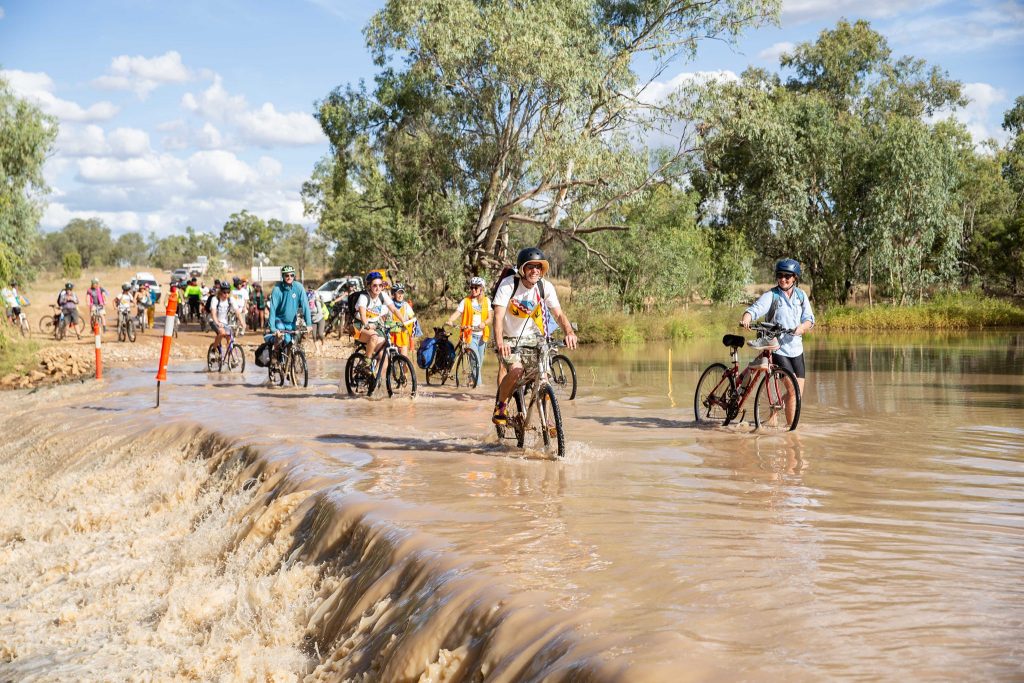
At another bend of the river we set up camp for the night after a very refreshing swim. Around the fire this time we heard from Coedie some of the history of resistance to Adani from Wangan and Jagalingou people.
With slightly sorer muscles we mounted the bikes again for day three, though by this point we were three quarters of the way to the mine. It was sad to say goodbye to the river, as we got back on the dusty road under a sun that was already glaring. We only had 17km of riding on this day though, which was done at a leisurely pace. It was amazing the way this land – which so many would describe as dull and monotonous – comes to life when travelling slowly, silently and in the open air. The strong colour contrast of dirt, trees and open sky, the sense of open space, the wildlife around us – butterflies flitting around, whistling kites constantly soaring overhead, little finches and big brolgas hanging around the waterholes. It was an experience of country in more ways than one. It made me think of the old aboriginal tradition of “walkabout” and how it helps us to understand our surroundings and connection to them in a way that you never will in a car no matter how many miles you cover.
We crossed Adani’s rail corridor, and passed the cattle grid where for four days last August the road to Adani’s workers camp was blocked by a Wangan and Jagalingou ceremonial fire. And not far from there we turned off into the bush, to go to our campsite for the night.
Dalgayu Dina means “big foot” in Wirdi language, so named because from an aerial shot the clearance in the trees looks like a giant footprint. This is the spot where Coedie and friends spent several months camping out after that roadblock – learning and practicing culture, and asserting their sovereignty over a piece of land that is in law part of Adani’s pastoral lease.
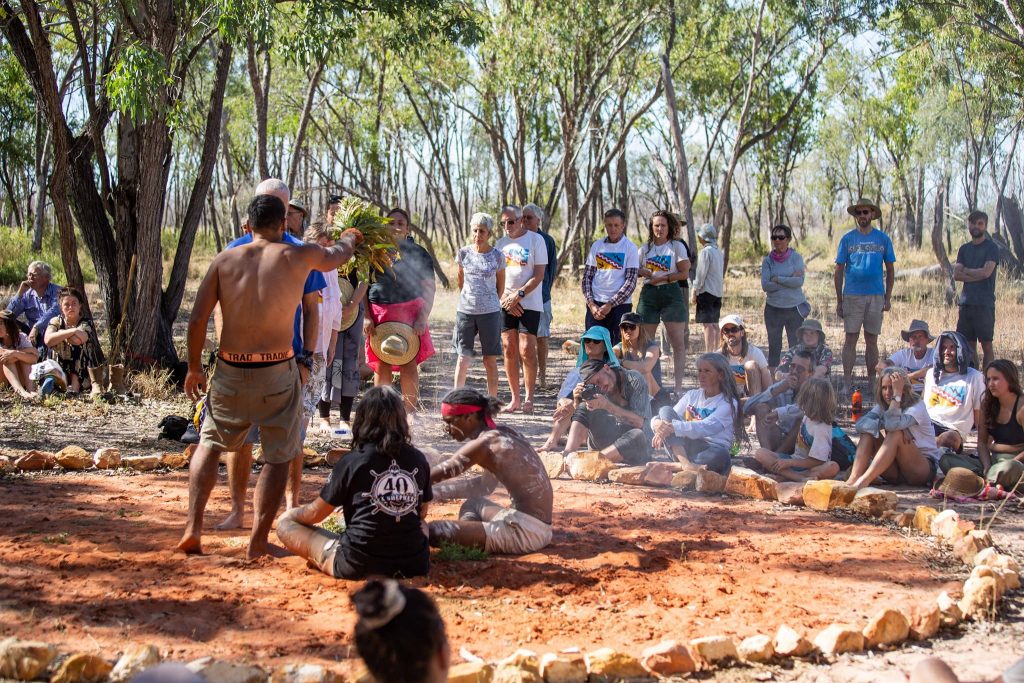
As Coedie, his sister Meisha and nephew Abraham undertook the mammoth task of a smoking ceremony that individually welcomed to country over 100 people; there was this extra significance to the ceremony. We were acknowledging Wangan and Jagalingou ownership of land that belongs, in title, to the company they are trying to stop from destroying it.
The 1996 Wik native title judgement ruled that pastoral lease did not override aboriginal ownership, a ruling Coedie has been putting to the test. Though the Queensland government extinguished the Wangan and Jagalingou claim over Adani’s mine site, this was a kind of DIY native title – going beyond the simple ritual of acknowledging country to put it into practice. The significance was not lost on Coedie. He said: “Adani has in the past tried to evict us from our own land, and when we resisted that they tried to grant permission only to Wangan and Jagalingou people. We haven’t accepted that, and this has opened up new precedents for Aboriginal people: going on to pastoral lease to practice and maintain their culture, and bringing non-indigenous people to put them through ceremony and have a cultural event without the hindrance of Adani or police.”
Coedie has successfully spent long stints of time at Dalgayu Dina, but there was some concern over how it would go bringing 100 whitefellas with him this time. But police kept to their customary spot hovering in the background, while Adani’s security parked their car across the road from the entrance. We set up camp, had another delicious dinner and more campfire yarns, and settled in for an uninterrupted night’s sleep.
It was a short ride from there the next morning to the donga settlement that is Adani’s workers’ camp. It’s from here each morning that they set out to work on digging the pit and building this end of the rail line, from here that employees fly to and from their homes after a seven day stint on the machines. A few workers were around to watch and film the passsing cavalcade, while riot cops (unsuitably dressed for the weather in their full length black getup) stood guarding the front entrance. We stopped for a while to have a look and make our presence felt, and then kept riding up the road to our final destination – the Carmichael mine box cut.
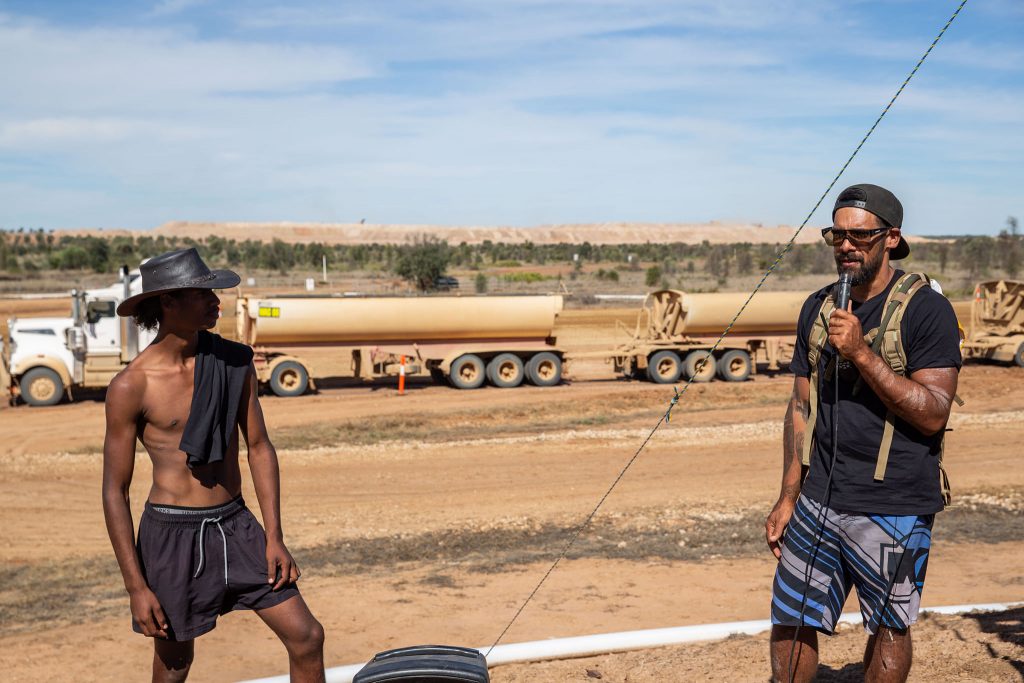
From the road, all that is visible of the mine is a mountain of overburden, with giant trucks regularly dumping another load on top. Beyond that is a vast hole – 600 by 900 metres, and currently about 10 metres deep. It’s a huge excavation, but amazingly is only a fraction of what Adani hopes to eventually build. The 60 million tonne per annum mine Adani originally touted would have stretched past us for kilometres in every direction. It’s a credit to the movement against Adani in all its forms that that mine is unlikely to ever be built.
To build it would have required something like a $15 billion loan, which no financial institution has ever offered – thanks largely to pressure from activists, including a world tour of banks by Wangan and Jagalingou back in 2015. It also would have required a new wider gauge rail line direct to Adani’s Abbott Point terminal. That line was never built, scuppered when activists pressured the Queensland government into vetoing a $1 billion loan of taxpayers money. Adani’s current approval is for just 10 mega tonnes per annum, a project they are financing themselves after no bank ever came through with a loan. The mine across from where we stood is no longer even called Adani – years of negative brand associations led Adani to change the name of its mining division to Bravus in an attempt to fly under the radar. While it was a depressing sight watching that dirt pile up, we had to also remember the wins we have had along the way.
We stopped outside the mine and heard from a few speakers – Coedie of course, but also an update on where the mine is up to from one of the Frontline Action on Coal stalwarts and a chat from Grant Howard, who for four decades worked in the coal industry but now was riding with us for climate action and indigenous self-determination. We posed for some photos with the mine in the background – the location providing a strange mix of feelings. Though the scene before us maybe wasn’t the most beautiful backdrop, we had made it to our destination. Despite the hysterical warnings about safety from Adani and the corporate media, we had barely required a band-aid. The bikes had all made it too, a bit dustier and with a few punctures patched up but all still pedalling. And we had all built new connections – to other people, to this part of the country, to the first people of this land and to the campaign to stop this disastrous coal mine form doing more damage than it has already.
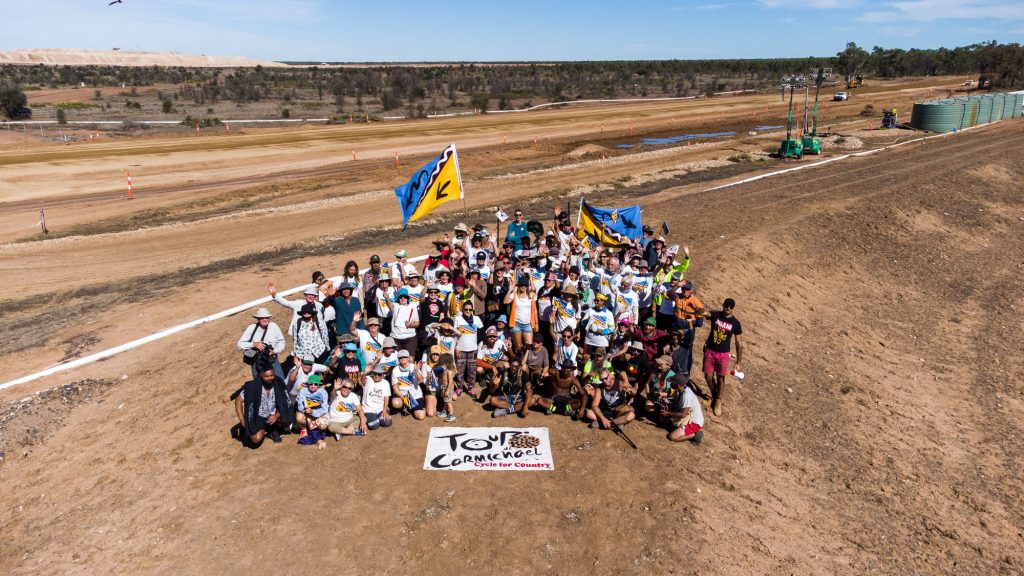
Back at Dalgayu Dina that night, after an impromptu didgeridoo concert from Coedie, we heard around the fire from those involved in all facets of the ongoing campaign to stop Adani – from Frontline Action on Coal putting bodies directly in the way of Adani’s machinery, to rural Stop Adani groups successfully pestering global insurance companies, to upcoming events discussing the next strategic steps. After all, what’s the point in connecting to country if we’re going to let it be destroyed by gaping holes and climate breakdown?
The ecosystems around the Belyando where we had spent the last few days are designed for resilience to tough conditions, but climate change is a real threat. So too is Adani’s coal handling plant, which has a licence to take 12.5 billion litres of water each year from the Suttor River system. The groundwater presents another serious risk – to dig down Adani will pump a lot of water (not counted on that water licence) out of their pit. That groundwater is extremely vital for the area, as much of the water flowing through it bubbles up from the nearby Doongmabulla Springs.
The springs are a sacred site for the Wangan and Jagalingou, and it’s easy to see why – a desert oasis whose water snakes its way through the dry country to the sea, hydrating all life along the way. The symbolism is potent. The threat to the springs is a good metaphor for natural life as a whole too – these ancient and intricate systems have developed over millions of years to sustain life as we know it, but it’s possible if you are so inclined to destroy it all very quickly.
For that reason, the Springs have played a powerful symbolic role in the campaign to stop Adani. Few people though have actually got to see them face to face. Hundreds of kilometres from the nearest town and deep into a private cattle station, they are not easy to get to. We were hoping to pay a visit to them as a final step, but alas it was not possible. Instead we packed up camp, said our farewells and began the journey back to our respective homes.
The Tour de Carmichael was over (for this edition anyway, everyone involved was keen to do it again), but the long ride towards climate and indigenous justice goes on. As Coedie said, “As Wangan and Jagalingou cultural custodians, it’s our duty to protect our country. So we’ll keep coming up with different ways to resist Adani.
by Andy Paine

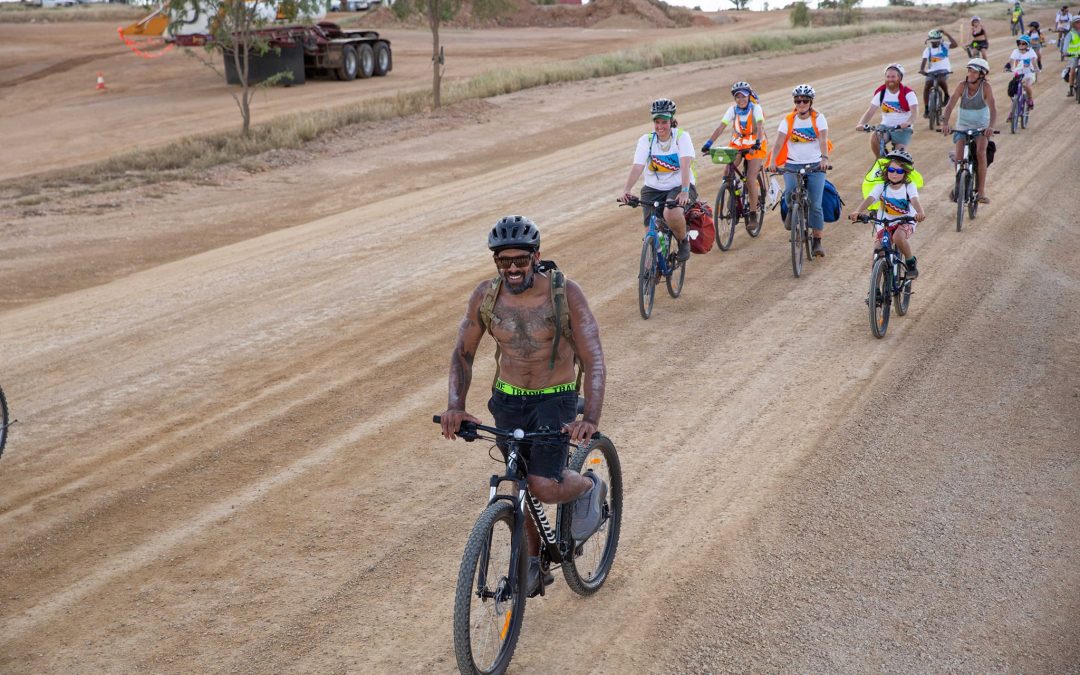
Recent Comments